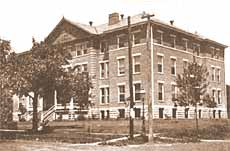|
Ahead
of his time in predicting the trends
Emil Stahlhut helped Lincoln
reach excellence in health care
Part
2
[DEC. 8, 2000]
Emil
Stahlhut, the first administrator of Abraham Lincoln Memorial
Hospital, who stayed in the job for 30 years, contributed a great
deal to this community, and his career brought the area a level of
excellence in health care not often found in a small town.
|
|
[click here for Part 1]
From 1955 until
1964, the old Deaconess Hospital had served as a nursing home. But, Jane
Stahlhut remembers, the old building was "just worn out." The decision
was made to build a 100-bed addition to ALMH to become a long-term care
facility. "That was Emilís project all the way," Sniff says.
"He had the help of a professional fund-raiser, but he oversaw the project
while he continued to run the day-to-day business of the hospital." The new
unit opened in October of 1964.

In 1966, 52 of the
100 beds were designated hospital beds. By 1981, because of Medicare funding
ceilings and other cost considerations, ALMH discontinued extended care service.
According to Emil
(and to many of those who know him) one of the highlights of his career was
assisting doctors to form a medical group. "Doctors were the last bulwark
of independent entrepreneurs," he says. "They didnít want to join a
group." But encouraged by Emil and his board, they began to see the
advantage of combining their practices, and in 1972 many doctors who had once
practiced alone joined to form the Abraham Lincoln Medical Group, with offices
in ALMH.

The medical group
was "the way of the future," Sniff says. "Emil saw that the only
way to attract new physicians to a small town was to have an organized group.
That way doctors could provide relief for each other and also share professional
concerns about patients. Physicians coming out of residency were looking for
that. It was the only way to get new young physicians to come to a rural
area."
"Emil was
ahead of his time," says Bob Albert, an old friend and fellow Rotary
member, who has also served on the ALMH board. "He was far advanced in
knowledge of what was going to happen in the future in the field of medicine. He
was well ahead of other administrators, even those in bigger hospitals. He was
aware of programs that could provide government money to benefit the hospital,
and he applied for these funds early on."

Albert also
remembers that Emil had the respect of his peers throughout the state.
"When I was going to hospital functions and meetings at the state level,
wherever administrators were gathered, people would say, ĎYouíre lucky you
have such a fellow as Emil running your hospital.í"
[to
top of second column in this section]
|

Sniff
agrees that the ALHM administrator was very well respected in the
industry. "Emil was a member of the Illinois Hospital
Association Board of Trustees for several years. He was also on the
Illinois Department of Public Health Hospital Licensing Board, an
appointment by the governorís office. Those are prestigious
positions. Iím sure he had opportunities to go elsewhere and chose
not to. He found satisfaction in what he did and the people he
worked with," Sniff says.

"A
lot of very positive things happened as a result of the formation of
the Abraham Lincoln Medical Group," says Jim White, manager of
the outpatient pharmacy at ALMH. The medical group brought together
doctors who had been practicing alone to practice together at ALMH.
(Later the doctorsí group moved out of the hospital and became the
Family Medical Group.)
"It
provided the base to attract new talent and helped us get
specialists to come to our small, rural community. In the early
days, if a patient wanted to see an orthopedic surgeon or a
dermatologist, that patient would have to go to a bigger city. With
the group, different specialists found it was worth their time to
come here once a week to see patients. This was especially good for
older people.
"Also,
because of the formation of the group, we had physicians on-site and
had 24-hour coverage in the emergency room. Early on, Emil saw that
a hospital needed that. And Emil, Dr. Gene Blaum and James
Strickland were instrumental in setting up a very progressive,
well-trained paramedic system," White explains.

"In the early days,
paramedics were employees of the hospital. When not giving care at
the scene, they worked in the emergency room. But even though they
are no longer part of the hospital, the standard of excellence of
the paramedics in Lincoln and Logan County is still alive and well.
If you go to other communities and assume you will find the same
level of expertise, you may be disappointed. The standard was
established in Emilís time, and today we still enjoy that standard
as a community."
(To be continued)
[Joan
Crabb]
|
|
Lincoln
Ag Center
1441 State
Route 10 East
Lincoln, IL
217-732-7948
We
support Lincolndailynews.com!
Click
here to visit our website!!! |
Blue
Dog Inn
111 S. Sangamon
217-735-1743
Open
for Lunch Mon.-Sat.
Open for Dinner Tues.-Sat.
Click
here to view our
menu and gift items |
25
Cents per
Gallon
Self-vendored
reverse osmosis water
The
Culligan
Fresh Water Station
318
N. Chicago St., Lincoln |
|
|
|
ALMHís first
administrator
Emil Stahlhut helped Lincoln
reach excellence in health care
Part 1
[DEC.
7, 2000] Before
Emil Stahlhut and his wife, Jane, came to Lincoln in May of 1953,
they hadnít stayed anywhere longer than three or four years. Emil
had served in the United States Army in World War II, earned a
degree in a new field, hospital administration, and worked in this
new profession at three different Midwest hospitals. But when they
got to Lincoln the Stahlhuts put down roots, and not only Abraham
Lincoln Memorial Hospital but the entire Lincoln community has
reason to be grateful.
|
|
Emil came as CEO
of the old Deaconess Hospital, specifically to oversee the merger of Deaconess
with the new Abraham Lincoln Memorial Hospital. Deaconess, located at the corner
of Seventh and Maple Streets (on what is now a parking lot), had opened its
doors in 1902.
Before World War
II, the Deaconess board had started planning to expand the hospital, but during
wartime no new building projects were possible because all of Americaís
resources were needed for the war effort. But in 1948, with the Hill-Burton Act,
federal money became available to build hospitals in rural areas. The Deaconess
board set out to hire a professional administrator, one who had education and
experience. Emil Stahlhut met all their qualifications.

Abraham Lincoln
Memorial Hospital, with Emil at the helm, opened on April 8, 1954, with a
maternity ward, a surgery ward and 100 beds. And instead of staying three or
four years, Emil stayed for 30, retiring in 1983 after a career that brought the
Lincoln area a level of excellence in health care not always found in a small
rural community.

Emil was born on a
farm in Madison County. After graduating from Edwardsville High School, he went
to Elmhurst College in Elmhurst. There he met Jane Sherman of Oak Park. They
were married in 1941, and he was drafted into the U. S. Army in 1942, after he
had finished all the work for a masterís degree in social work except for his
thesis.
[to
top of second column in this section]
|

"The
Army didnít know what to do with a social worker, so they put me
in the medical department," he says. He became a captain in the
Medical Administration Corps, and, he remembers, "By the time I
got out of the Army I had been in the medical field longer than in
social work."
A new
field was opening up, and Emil was interested, so he got a degree in
hospital administration at Northwestern University in Evanston. He
served as a medical administrative officer at Hines Veterans
Hospital in Maywood, then went to Mount Sinai Hospital in Chicago as
assistant administrator. After that, the Stahlhuts went to
Maquoketa, Iowa, where Emil opened a hospital. They stayed for three
years, then came to Lincoln.

When he became the
administrator at Abraham Lincoln Memorial Hospital (ALMH), Emil
"did it all," says David Sniff, his first administrative
assistant. "From the opening of the hospital until 1963, when
Jim LaMothe became the first fiscal officer, Emil did everything,
from payroll to ordering supplies and drugs to the finances --
whatever had to be done," Sniff recalls. "He was very
disciplined, very hardworking." (Sniff himself came on board in
1974, left in 1980, then came back in January of 1983, when Emil
retired, and stayed until 1995.)
(To be continued)
[Joan
Crabb]
[click
here for Part 2]
|
|
|
|

